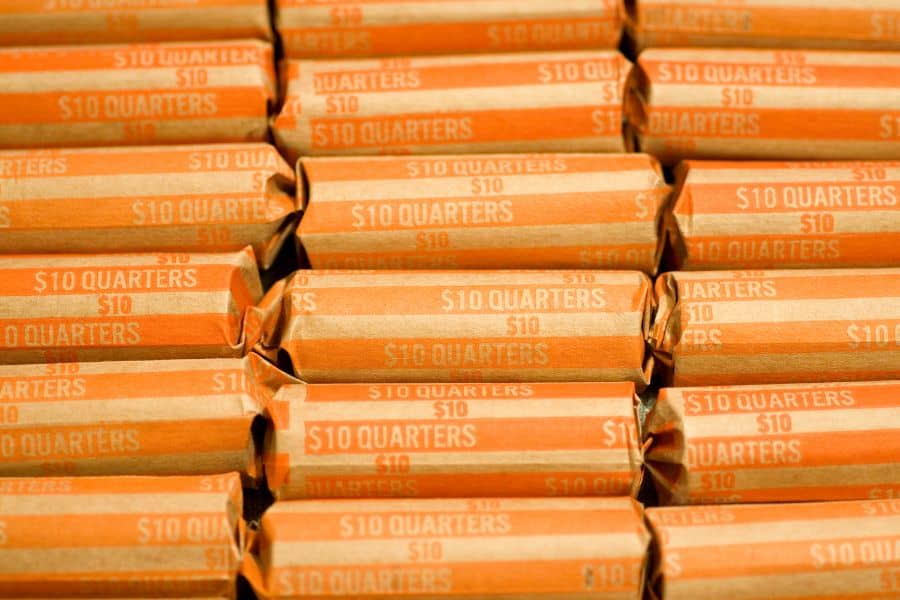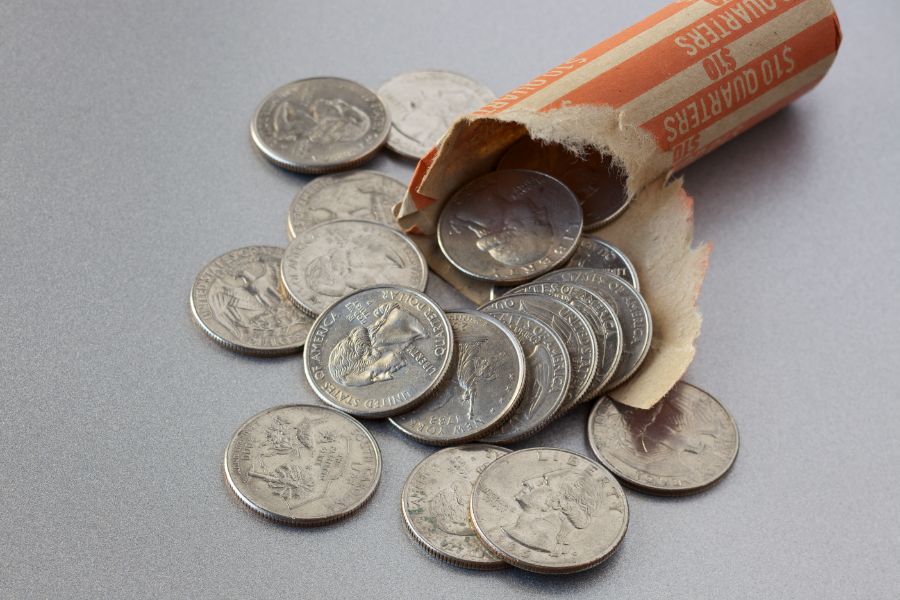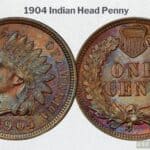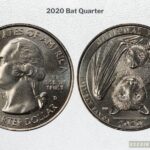Quarters, those small silver coins, may seem insignificant on their own, but they can quickly add up when rolled into a neat bundle.
If you’ve ever wondered about the value of a roll of quarters or how many quarters make up a roll, this article is for you.
A standard roll of quarters is worth $10 and contains 40 quarters. However, the number of quarters in a roll can vary if private companies or individuals wrap it.
In such cases, you can expect various variations, including half rolls with half as many coins or double rolls with double as much.
Read on to dive into this comprehensive guide about quarter rolls, answering your questions about their value and much more. We will also explore the world of coin rolls, the reasons behind their use, their value, and how to prepare coin rolls for the bank.
What Are Coin Rolls & Where They Come From
Coin rolls are cylindrical wrappers that hold a specific number of coins of the same denomination, typically wrapped in paper or plastic sealed at both ends to keep the coins secure.
Coin rolls are available in all coin denominations, including pennies, nickels, dimes, half-dollars, dollars, and quarters. They are color-coded and labeled with the denomination they contain, making it easy to identify the type of coins inside.
Also, the number of coins in a roll depends on the denomination. The table below shows how many coins go into each roll:
| Coin Rolls | Number of Coins in A Roll | Weight of the Roll (grams) | Value of the Roll | Color of Roll/Wrapper |
| Penny/1 Cent (1¢) Rolls | 50 | 125 | $0.50 | Red |
| Nickel (5¢) Rolls | 40 | 200 | $2.00 | Blue |
| Dime (10¢) Rolls | 50 | 113.4 | $5.00 | Green |
| Quarter (25¢) Rolls | 40 | 226.8 | $10.00 | Orange |
| Half Dollar (50¢) Rolls | 20 | 226.8 | $10.00 | Yellow |
| Small Dollar ($1) Rolls | 25 | 202.5 | $25.00 | Grey |
| Large Dollar ($1) Rolls | 20 | 453.6 | $20.00 | White |
Coin rolls, sometimes known as bank rolls, rolls, or coin wrappers, came into the market in the 19th Century. Coins from the United States Mint and the Federal Reserve Bank were distributed through large cloth bags or by manually hand-wrapping the coins in plastic or paper wrappers that were color-coded and striped.
It wasn’t until the 20th Century, in 1901, when James Rice patented the first ever coin counting machine, dubbed the “Coin Bunching Machine.” Later, in 1910, Charles S. Batdorf patented the first automatic coin-wrapping machines. By 1913, coin-rolling machines were an everyday item in United States banks.
At this time, the Federal Reserve bank was created, and standardized paper rolls with color-coded denominations became the norm. Apart from counting and rolling coins, these machines were able to detect fake coins as well as damaged ones.
Related: How Much Does a Quarter Weigh?
Why Coin Rolls Are Used
The use of coin rolls dates back to the early 20th Century when the Federal Reserve was formed. Since their job is to buy coins from the United States Mint and distribute them to the banks and credit unions, the Federal Reserve came up with a way to streamline the process by using coin rolls and coin boxes.
Today, coin rolls are used for various reasons:
- Bank Deposits: You can deposit your coins in a bank or exchange them for bills. Most banks prefer coin rolls since they are more manageable for bank tellers and make the deposit process smoother.
- Coin Collection & Sorting: Coin collectors use coin rolls to store and protect their coins. Rolls keep coins organized and prevent damage. Instead of a jumbled mess of coins, you can neatly stack coins in rolls, making it easier to count and manage your funds.
- Valuable collectible coins: Collectible coins like uncirculated quarters are often sold to collectors at a premium. These coins are packaged neatly in coin rolls for easier storage and purchase of larger quantities.
- Storage and Transport: They are useful for securely transporting and storing large quantities of coins.
- Coin Roll Hunting: This is the practice of obtaining/ ‘hunting’ coin rolls from the bank or retailers and searching through them for valuable or collectible coins. Serious coin roll hunters often keep detailed coin rolls to record their finds, including dates, mint marks, conditions, and errors. This helps them track their finds.
Other Types Unstandardized/Specialized Coin Rolls – Half Rolls, Double Rolls,
Standard coin rolls hold a fixed number of coins designated by the U.S. Mint and the Federal Reserve. However, there are a few instances where individuals or companies might opt to use unstandardized/specialized coin rolls.
An example of this include:
- Half Rolls: These are smaller coin rolls that hold half the standard quantity. For quarters, a half roll would contain 20 coins.
- Double Rolls: These are larger coin rolls and can hold twice the standard quantity. For quarters, this means 80 coins in a double roll.
Collectors often use these unstandardized coin rolls because they are handy in making their collections fancier and more appealing to the market.
Value of Roll of Quarters
The face value of the coins determines the value of a standard roll of quarters within.
So, how much in a roll of quarters?
In the United States, each quarter has a face value of 25 cents ($0.25). Therefore, the standard roll of quarters is worth $10 = $0.25 x 40 quarters. This value remains consistent unless you’re dealing with specialized rolls like double or half rolls.
How Many Quarters in A Roll of $10

For example, how many quarters are in two rolls (also known as Double Dolls? In this case, the two rolls consist of two standard rolls of quarters, which equates to 80 quarters. The value of the two rolls is $20 since each quarter is worth $0.25 ($0.25 x 80)
Features of a Roll of Quarters
The U.S. quarter is 0.995 inches in diameter and 0.0689 inches thick. Therefore, the standard quarter roll has the following dimensions and size provided it consists of a uniform metal composition and regularity:
- Volume of the Roll of Quarters:049334 cubic inches
- Thickness of the Roll of Quarters:0689 inches
- Height of the Roll of Quarters: 2.76 inches tall
How to Count and Roll Your Coins – Preparing Coins For The Bank
If you are wondering how to get coin rolls from the bank, then do not worry because it is a straightforward process. Simply visit your bank and request the number of rolls you need. They may have pre-rolled quarters or loose quarters that they can provide, which you can then roll yourself.
So, how do you prepare the coins into rolls?
The coin-rolling process can be done in two ways – manually through hand rolling or automatically with the help of a coin-rolling machine.
The method you prefer is up to you. However, you should know that using an automatic machine is the easiest way and saves time. For this method, follow the instructions on the machine to roll your coins.
Hand rolling, on the other hand, is laborious but allows for up close inspection when coin hunting. Follow the step-by-step instructions below to roll your coins into coin wrappers:
Materials Needed: Loose coins of the same denomination (quarters), orange coin wrappers (paper or plastic) made specifically for quarters, marking pen/pencil, and a flat surface
Steps
- Step 1:
Gather the container with the quarters and spread them on a flat surface. You can inspect them for any errors, deformities, and mint marks for collectible or evaluation purposes.
Separate the quarters you want to roll onto one side.
- Step 2:
Take the quarters you want to roll and arrange them on top of one another to count them. The coin wrappers may have a label that shows their value when filled to the ends with coins.
This will give you an idea of how much you will get for each full roll of quarters – $10 for a full roll of quarters holding 40 coins.
- Step 3:
Proceed to fill the rolls by placing the appropriate number of coins in each roll.
- Step 4:
Proceed to seal the rolls. Fold the ends of the paper wrapper, or use adhesive closures for plastic rolls to secure the coins in place.
- Step 5:
Finish up by labeling the wrapper using the marker pen. Write the denomination and the total value on the coin wrapper. This makes it easier to identify and deposit them at the bank.
- Step 6:
Continue the process until you have rolled all your coins or until you’ve filled all available wrappers.
Note: Banks only count full coin rolls. Therefore, you are required only to provide full coin rolls when exchanging them at the bank.
Frequently Asked Questions
1. Is a roll of quarters $10 or $20?
The answer depends on whether you have a standard quarter roll or a specialized set of quarter rolls.
A standard roll of quarters contains 40 coins, each with a face value of $0.25. Therefore, this roll of quarters is worth $10 in total.
However, unstandardized specialized coin rolls can be worth $20 if they are Double Rolls – containing 80 coins instead of 40, making the total value $20.
2. How Many 50 Coins In A Roll?
The only coin rolls in the United States with 50 coins are the dime and penny/cent rolls. A roll of 50 pennies is worth $0.50 ($0.01 x 50), and a roll of dimes is worth $5 ($0.10 x 50).
3. Where To Buy Coin Rolls And Coin Wrappers?
Coin rolls or wrappers are easily found at the local bank, or you can search for retailers online or around your local area. Coin rolls are inexpensive, and you may get them for free from some banks or retailers.
Conclusion
Whether you’re a coin collector or simply curious about the value of your loose change, understanding the number of quarters in a roll is valuable information.
Remember that rolls of quarters are available in a variety of formats, both standard and specialized. The standard roll of quarters is the most commonly used, which consists of 40 quarters and is worth $10 when full.



